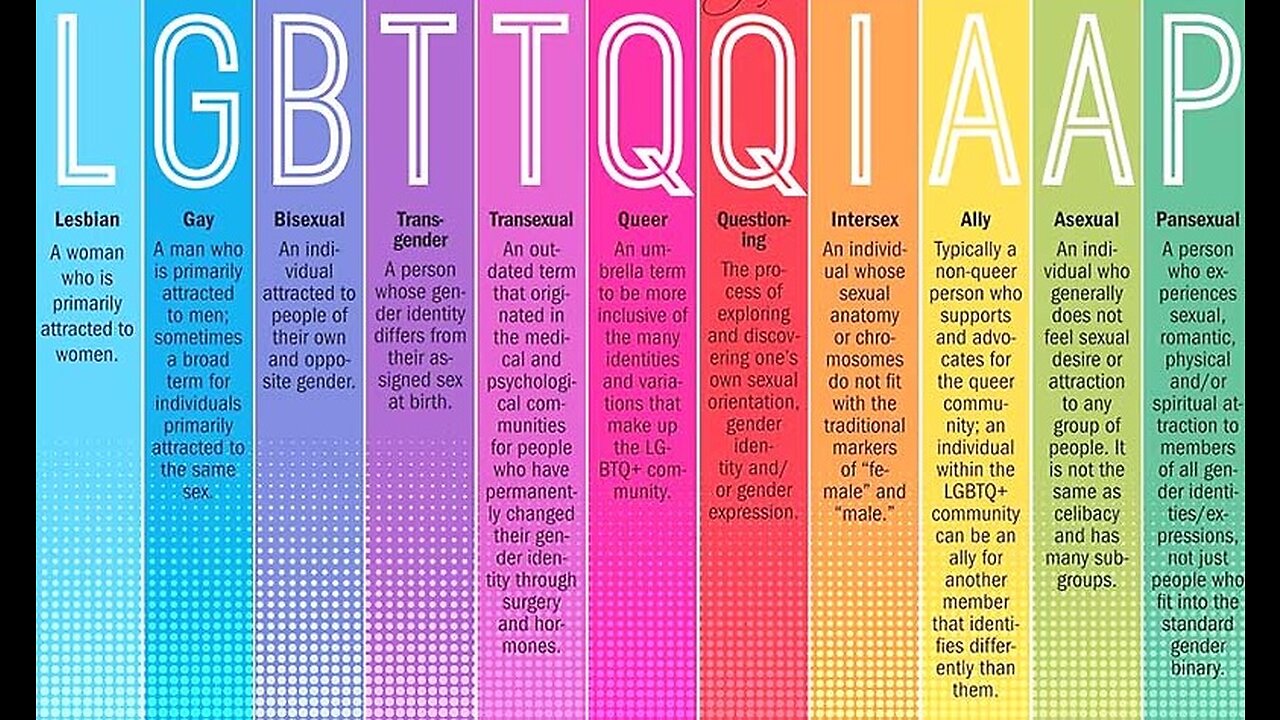Premium Only Content

Doctor Exposes Transgender Propaganda Movement Industry Is Existence Pronouns
Endocrinologist from California explains the devastating effects that puberty blockers, cross-sex hormones, and surgical modifications can have on children's developing bodies. The Transgender Industry Is Culling Tomboys Out Of Existence. Sometimes transgender propaganda is too honest for its own good. For example, Loudoun Now, a weekly newspaper in Virginia’s Loudoun County, just ran a horrifying story encouraging gender dysphoria in children.
The piece focuses on seven-year-old Sophia, now pretending to be a boy named Max, and her mother Emily (the unnamed father is almost entirely absent from the article). It was meant to boost transgender ideology in an area that has become a battleground over transgenderism and critical race theory in schools, but it inadvertently reveals several ugly truths about the trans-kids movement.
First, this story shows that the transgender movement is coming for very young children, starting in preschool if not sooner. Transgender advocates insist that kindergarteners and even toddlers are capable of committing to transition, and that everyone else must affirm this. Instead of waiting to see what shakes out as children develop, trans advocates demand that children be immediately transitioned socially (new names, new clothes, new pronouns, new bathrooms, etc.), followed by medical transition beginning before puberty.
Second, the Loudoun Now piece reveals that sexism is the basis for transitioning these little children. We are told that, as a toddler, “Sophia showed a preference for ‘boy toys’ and sports” though Emily “continued to offer dresses and dolls, thinking Sophia would eventually show interest.” But when Sophia was only five, Emily gave up on her efforts to interest her tomboy daughter in girly-girl stuff, and decided that what she really had was a transgender son.
In this, Emily followed fashionable opinion, which has shifted from insisting that it is fine, even good, for girls to like sports, trucks, and other stereotypical boy stuff to declaring that such girls must really be boys. Goodbye tomboys, hello trans-boys.
The biggest sources of sex stereotypes and strict gender roles in America today are the trans movement and its allies. Many self-described feminists have knuckled under, cheering as it is said that girls should stick to dresses and dolls and that girls who like “boy” things must actually be boys. The transgender movement is far more sexist than the most retrograde, fundamentalist Christians I’ve ever known — at least the latter still let their daughters enjoy basketball and PE.
Third, this case demonstrates how it is often adults who are pushing for children to transition. The reporter says, “It never occurred to Sophia that she was anyone other than a boy,” which makes it odd that the story does not relate any instances of Sophia saying that she was, or wanted to be, a boy. No evidence is provided for this central claim of the story.
Instead, the article tells about Sophia, then around five years of age, admiring Max from “Stranger Things” to the point of wanting to be called Max. This is presented as a major milestone in revealing Sophia’s trans identity. But “Stranger Things’” Max is a girl. This was nothing more than one tomboyish little girl admiring and wanting to be like an older tomboyish girl on TV.
Indeed, reading the story, which relies entirely on Emily for pertinent information about Sophia/Max, it is striking that no evidence of gender dysphoria is presented beyond a little girl being a tomboy. However, it does appear Emily was distressed at her daughter being a tomboy instead of a girly girl, and we are told that Emily can now get her little “boy” to cooperate in dressing up, albeit in bow-ties and button-down shirts rather than dresses.
We are also told that following the first foray, “Emily started trashing the girl clothes in the closet.” Perhaps “trashing” was just color added by the reporter, and Emily actually gave them away. But if it is accurate, it suggests seething bitterness. Regardless, it was clearly Emily, not Sophia, driving the declaration of a transgender identity for Sophia.
Fourth, this story illustrates the pernicious effects of the trans movement’s hostage-taking. Emily admits to concerns about the future medical transition of her daughter, but dismisses them by repeating word for word the trans movement’s mantra, “I’d rather have a trans son than a dead daughter.” Yet this story presents no evidence that Sophia ever considered, let alone threatened or attempted, suicide. Emily’s fear seem to be entirely instilled from outside sources.
It is true that people who identify as transgender have high rates of suicide and self-harm, but identifying as transgender has not been shown to reduce this. Furthermore, Sophia did not consider herself transgender until adults, led by her mother, introduced the concept to her (indeed, she still might not understand it). Far from helping her daughter, it seems that Emily pinned a trans identity on her, and is now writing her a suicide script to use as a threat against anyone who does not affirm this identity.
Although the Loudoun Now story was an attempt at pro-trans propaganda, it inadvertently let the truth out. The reader is left to fill in the gaps in some omissions, but it clearly shows how the trans movement is filling parents’ minds with propaganda and fear to induce them to transition very young children based on crude sex stereotypes. In this case, a seven-year-old girl is now a handful of years away from permanent body mutilation and sterility via puberty blockers, cross-sex hormones, and surgery. Pour one out for the tomboys, because those rambunctious little girls are about to be transitioned out of existence.
WITHIN THE LGBTTQQIAAP+ COMMUNITY GENDER PRONOUNS ARE VERY IMPORTANT TO MANY - A word that can function by itself as a noun phrase and that refers either to the participants in the discourse (e.g., I, you) or to someone or something mentioned elsewhere in the discourse (e.g., she, it, this). Why is it important to respect a person’s Gender pronoun?
How can we assume what someone’s pronouns are just by looking at them? What a privilege we have to believe that we can just assume how someone identifies. It truly is a privilege to not have to say my pronouns or worry about whether or not someone is going to use the correct pronouns for me. Respecting all people is a huge step in healing our world and we can do this by asking and correctly using someone’s pronouns. Imagine being disrespected because someone doesn’t understand you or like you just because of who you are. It doesn’t feel good nor is it acceptable, so when someone is referred to with the wrong pronoun, it can make them feel disrespected and not validated.
We have to watch where we have privilege in all areas otherwise it can be oppressive to others who do not have that privilege.
How do I ask someone about what Pronouns do they use?
Just like you ask someone, “What is your name”, try asking them: “What pronouns do you use?” As I mentioned earlier, assumptions are not good and they can be harmful to that person in front of you. So even though it might seem awkward at first, it’s worth trying to get it right the very first time.
What if I make a mistake?
As with anything in life we make mistakes. It is a natural part of human existence. We are not perfect beings so with that there is a chance that you will make a mistake when seeking to identify someone by the correct pronoun. Here is the thing: If you recognize that a mistake was made after you have said it, hopefully, human nature will step in and you will apologize, use the correct language and move on.
A huge mistake when trying to correct your wrong is having the desire to prolong the conversation about how bad you feel that you made a mistake. This is not wise to do because what could end up happening is that the person who was identified incorrectly could now began to feel like they have to now comfort you and that is not fair to them.
A Guide To Gender Identity Terms and Pronouns
Issues of equality and acceptance of transgender and nonbinary people — along with challenges to their rights — have become a major topic in the headlines. These issues can involve words and ideas and identities that are new to some.
That's why we've put together a glossary of terms relating to gender identity. Our goal is to help people communicate accurately and respectfully with one another.
Proper use of gender identity terms, including pronouns, is a crucial way to signal courtesy and acceptance. Alex Schmider, associate director of transgender representation at GLAAD, compares using someone's correct pronouns to pronouncing their name correctly – "a way of respecting them and referring to them in a way that's consistent and true to who they are."
Glossary of gender identity terms
This guide was created with help from GLAAD. We also referenced resources from the National Center for Transgender Equality, the Trans Journalists Association, NLGJA: The Association of LGBTQ Journalists, Human Rights Campaign, InterAct and the American Psychological Association. This guide is not exhaustive, and is Western and U.S.-centric. Other cultures may use different labels and have other conceptions of gender.
One thing to note: Language changes. Some of the terms now in common usage are different from those used in the past to describe similar ideas, identities and experiences. Some people may continue to use terms that are less commonly used now to describe themselves, and some people may use different terms entirely. What's important is recognizing and respecting people as individuals.
Jump to a term: Sex, gender, gender identity, gender expression, cisgender, transgender, nonbinary, agender, gender-expansive, gender transition, gender dysphoria, sexual orientation, intersex
Jump to Pronouns: questions and answers
Sex refers to a person's biological status and is typically assigned at birth, usually on the basis of external anatomy. Sex is typically categorized as male, female or intersex.
Gender is often defined as a social construct of norms, behaviors and roles that varies between societies and over time. Gender is often categorized as male, female or nonbinary.
Gender identity is one's own internal sense of self and their gender, whether that is man, woman, neither or both. Unlike gender expression, gender identity is not outwardly visible to others.
For most people, gender identity aligns with the sex assigned at birth, the American Psychological Association notes. For transgender people, gender identity differs in varying degrees from the sex assigned at birth.
Gender expression is how a person presents gender outwardly, through behavior, clothing, voice or other perceived characteristics. Society identifies these cues as masculine or feminine, although what is considered masculine or feminine changes over time and varies by culture.
Cisgender, or simply cis, is an adjective that describes a person whose gender identity aligns with the sex they were assigned at birth.
Transgender, or simply trans, is an adjective used to describe someone whose gender identity differs from the sex assigned at birth. A transgender man, for example, is someone who was listed as female at birth but whose gender identity is male.
Cisgender and transgender have their origins in Latin-derived prefixes of "cis" and "trans" — cis, meaning "on this side of" and trans, meaning "across from" or "on the other side of." Both adjectives are used to describe experiences of someone's gender identity.
Nonbinary is a term that can be used by people who do not describe themselves or their genders as fitting into the categories of man or woman. A range of terms are used to refer to these experiences; nonbinary and genderqueer are among the terms that are sometimes used.
Agender is an adjective that can describe a person who does not identify as any gender.
Gender-expansive is an adjective that can describe someone with a more flexible gender identity than might be associated with a typical gender binary.
Gender transition is a process a person may take to bring themselves and/or their bodies into alignment with their gender identity. It's not just one step. Transitioning can include any, none or all of the following: telling one's friends, family and co-workers; changing one's name and pronouns; updating legal documents; medical interventions such as hormone therapy; or surgical intervention, often called gender confirmation surgery.
Gender dysphoria refers to psychological distress that results from an incongruence between one's sex assigned at birth and one's gender identity. Not all trans people experience dysphoria, and those who do may experience it at varying levels of intensity.
Gender dysphoria is a diagnosis listed in the Diagnostic and Statistical Manual of Mental Disorders. Some argue that such a diagnosis inappropriately pathologizes gender incongruence, while others contend that a diagnosis makes it easier for transgender people to access necessary medical treatment.
Sexual orientation refers to the enduring physical, romantic and/or emotional attraction to members of the same and/or other genders, including lesbian, gay, bisexual and straight orientations.
People don't need to have had specific sexual experiences to know their own sexual orientation. They need not have had any sexual experience at all. They need not be in a relationship, dating or partnered with anyone for their sexual orientation to be validated. For example, if a bisexual woman is partnered with a man, that does not mean she is not still bisexual.
Sexual orientation is separate from gender identity. As GLAAD notes, "Transgender people may be straight, lesbian, gay, bisexual or queer. For example, a person who transitions from male to female and is attracted solely to men would typically identify as a straight woman. A person who transitions from female to male and is attracted solely to men would typically identify as a gay man."
Intersex is an umbrella term used to describe people with differences in reproductive anatomy, chromosomes or hormones that don't fit typical definitions of male and female.
Intersex can refer to a number of natural variations, some of them laid out by InterAct. Being intersex is not the same as being nonbinary or transgender, which are terms typically related to gender identity.
Nonbinary Photographer Documents Gender Dysphoria Through A Queer Lens
THE PICTURE SHOW
Nonbinary Photographer Documents Gender Dysphoria Through A Queer Lens
Pronouns: questions and answers - What is the role of pronouns in acknowledging someone's gender identity?
Everyone has pronouns that are used when referring to them – and getting those pronouns right is not exclusively a transgender issue.
"Pronouns are basically how we identify ourselves apart from our name. It's how someone refers to you in conversation," says Mary Emily O'Hara, a communications officer at GLAAD. "And when you're speaking to people, it's a really simple way to affirm their identity."
"So, for example, using the correct pronouns for trans and nonbinary youth is a way to let them know that you see them, you affirm them, you accept them and to let them know that they're loved during a time when they're really being targeted by so many discriminatory anti-trans state laws and policies," O'Hara says.
"It's really just about letting someone know that you accept their identity. And it's as simple as that."
Getting the words right is about respect and accuracy, says Rodrigo Heng-Lehtinen, deputy executive director of the National Center for Transgender Equality.
Kaz Fantone for NPR - What's the right way to find out a person's pronouns?
Start by giving your own – for example, "My pronouns are she/her."
"If I was introducing myself to someone, I would say, 'I'm Rodrigo. I use him pronouns. What about you?' " says Rodrigo Heng-Lehtinen, deputy executive director of the National Center for Transgender Equality.
O'Hara says, "It may feel awkward at first, but eventually it just becomes another one of those get-to-know-you questions."
Should people be asking everyone their pronouns? Or does it depend on the setting? Knowing each other's pronouns helps you be sure you have accurate information about another person. How a person appears in terms of gender expression "doesn't indicate anything about what their gender identity is," GLAAD's Schmider says. By sharing pronouns, "you're going to get to know someone a little better."
And while it can be awkward at first, it can quickly become routine.
Heng-Lehtinen notes that the practice of stating one's pronouns at the bottom of an email or during introductions at a meeting can also relieve some headaches for people whose first names are less common or gender ambiguous.
"Sometimes Americans look at a name and are like, 'I have no idea if I'm supposed to say he or she for this name' — not because the person's trans, but just because the name is of a culture that you don't recognize and you genuinely do not know. So having the pronouns listed saves everyone the headache," Heng-Lehtinen says. "It can be really, really quick once you make a habit of it. And I think it saves a lot of embarrassment for everybody."
Might some people be uncomfortable sharing their pronouns in a public setting?
Schmider says for cisgender people, sharing their pronouns is generally pretty easy – so long as they recognize that they have pronouns and know what they are. For others, it could be more difficult to share their pronouns in places where they don't know people.
But there are still benefits in sharing pronouns, he says. "It's an indication that they understand that gender expression does not equal gender identity, that you're not judging people just based on the way they look and making assumptions about their gender beyond what you actually know about them."
How is "they" used as a singular pronoun?
"They" is already commonly used as a singular pronoun when we are talking about someone, and we don't know who they are, O'Hara notes. Using they/them pronouns for someone you do know simply represents "just a little bit of a switch."
"You're just asking someone to not act as if they don't know you, but to remove gendered language from their vocabulary when they're talking about you," O'Hara says.
"I identify as nonbinary myself and I appear feminine. People often assume that my pronouns are she/her. So they will use those. And I'll just gently correct them and say, hey, you know what, my pronouns are they/them just FYI, for future reference or something like that," they say.
O'Hara says their family and friends still struggle with getting the pronouns right — and sometimes O'Hara struggles to remember others' pronouns, too.
"In my community, in the queer community, with a lot of trans and nonbinary people, we all frequently remind each other or remind ourselves. It's a sort of constant mindfulness where you are always catching up a little bit," they say.
"You might know someone for 10 years, and then they let you know their pronouns have changed. It's going to take you a little while to adjust, and that's fine. It's OK to make those mistakes and correct yourself, and it's OK to gently correct someone else." What if I make a mistake and misgender someone, or use the wrong words?
Simply apologize and move on.
"I think it's perfectly natural to not know the right words to use at first. We're only human. It takes any of us some time to get to know a new concept," Heng-Lehtinen says. "The important thing is to just be interested in continuing to learn. So if you mess up some language, you just say, 'Oh, I'm so sorry,' correct yourself and move forward. No need to make it any more complicated than that. Doing that really simple gesture of apologizing quickly and moving on shows the other person that you care. And that makes a really big difference."
Why are pronouns typically given in the format "she/her" or "they/them" rather than just "she" or "they"?
The different iterations reflect that pronouns change based on how they're used in a sentence. And the "he/him" format is actually shorter than the previously common "he/him/his" format.
"People used to say all three and then it got down to two," Heng-Lehtinen laughs. He says staff at his organization was recently wondering if the custom will eventually shorten to just one pronoun. "There's no real rule about it. It's absolutely just been habit," he says.
Amid Wave Of Anti-Trans Bills, Trans Reporters Say 'Telling Our Own Stories' Is Vital
NATIONAL
Amid Wave Of Anti-Trans Bills, Trans Reporters Say 'Telling Our Own Stories' Is Vital - But he notes a benefit of using he/him and she/her: He and she rhyme. "If somebody just says he or she, I could very easily mishear that and then still get it wrong."
What does it mean if a person uses the pronouns "he/they" or "she/they"?
"That means that the person uses both pronouns, and you can alternate between those when referring to them. So either pronoun would be fine — and ideally mix it up, use both. It just means that they use both pronouns that they're listing," Heng-Lehtinen says.
Schmider says it depends on the person: "For some people, they don't mind those pronouns being interchanged for them. And for some people, they are using one specific pronoun in one context and another set of pronouns in another, dependent on maybe safety or comfortability." The best approach, Schmider says, is to listen to how people refer to themselves.
Why might someone's name be different than what's listed on their ID? Heng-Lehtinen notes that there's a perception when a person comes out as transgender, they change their name and that's that. But the reality is a lot more complicated and expensive when it comes to updating your name on government documents.
"It is not the same process as changing your last name when you get married. There is bizarrely a separate set of rules for when you are changing your name in marriage versus changing your name for any other reason. And it's more difficult in the latter," he says.
"When you're transgender, you might not be able to update all of your government IDs, even though you want to," he says. "I've been out for over a decade. I still have not been able to update all of my documents because the policies are so onerous. I've been able to update my driver's license, Social Security card and passport, but I cannot update my birth certificate."
"Just because a transgender person doesn't have their authentic name on their ID doesn't mean it's not the name that they really use every day," he advises. "So just be mindful to refer to people by the name they really use regardless of their driver's license."
As more people become aware of the transgender and gender-nonconforming experience, many may be uncertain about the terminology used by these communities.
Here, a NewYork-Presbyterian expert breaks down some of the terms that are used to describe the spectrum of gender identity to help people better understand both the language and how to create a more inclusive environment for the estimated 1 million adults in the U.S. who identify as transgender.
One of the first steps is understanding the use of a person’s personal pronouns rather than making assumptions. This is widely accepted as a way to treat a transgender person with respect, according to Marianna Stayer, LMSW, program manager at NewYork-Presbyterian’s Center for Special Studies and a LGBTQ advocate. For example, when you meet someone, ask which personal pronouns to use to honor them. The most commonly used pronouns are “she” and “her”; “he” and “him”; and “they” and “them.” However, it’s important to recognize that many other pronouns also exist. You can start by sharing your own preferences by saying “Hi, I’m Levi, and my personal pronouns are he and him. What are yours?”
Another good way to learn personal pronouns is to listen to find out if an individual uses pronouns that are masculine, feminine, or neutral, such as “they” and “them.”
If you accidentally use the wrong pronoun, apologize quickly and sincerely, then move on. The bigger deal you make out of the situation, the more uncomfortable it is for everyone.
“People might not realize they make a lot of assumptions about someone’s identity,” says Stayer. “To help make somebody feel welcome, it’s important to step back from assumptions a little bit and speak to people about how they personally identify themselves.”
Here, Stayer explains some common terms that represent a number of identities in the transgender and gender-nonconforming communities.
Agender – someone who identifies as having no gender or being without a gender identity (genderless, gender-free, nongendered, ungendered)
Androgynous – someone whose gender expression is a combination of masculine and feminine characteristics
Bigender, trigender, pangender – someone who identifies with two or more genders
Cisgender – a person whose sense of personal identity and gender corresponds with their sex assigned at birth
Gender expression – refers to the aspects of a person’s behavior, mannerisms, interests, and appearance that are associated with gender in a particular cultural context, specifically with the categories of femininity or masculinity
Gender fluid – someone who does not identify as having a fixed/static gender
Gender nonconforming – gender expression by an individual that does not match masculine and feminine gender norms
Gender queer – someone who does not subscribe to conventional gender distinctions but identifies with neither, both, or a combination of male and female genders
Nonbinary – someone who identifies outside of the gender binary; does not identify with masculinity or femininity as it is culturally defined
TGNC – transgender and gender nonconforming
Transfeminine – describes a person who was assigned male at birth but identifies on the feminine spectrum
Transgender – a person whose sense of personal identity and gender does not correspond with their sex assigned at birth
Transmasculine – describes a person who was assigned female at birth but identifies on the masculine spectrum
What are Pronouns?
Pronouns are the way that we refer to people in place of their name or in third person (referring to that person while talking to someone else). Often, pronouns have an implied gender such as “he” to refer to a man/boy or “she” to refer to a woman/girl. People may also make assumptions about the gender of a person based upon their appearance or their name. In both cases, these assumptions aren’t always correct, accurate, or helpful. In fact, in our workplaces, schools, and communities, these messages can be harmful and damaging to relationships.
When you use someone’s correct pronouns, it serves to create an inclusive environment where you demonstrate that you care for and respect them. Just as we wouldn’t want to make up a nickname for someone and use it against their will, it can be just as upsetting or disrespectful to refer to someone using incorrect pronouns. Actively choosing to not use the pronouns someone has shared that they go by is harassment and implies that intersex, transgender, non-binary, and gender nonconforming people do not or should not exist.
How do I use Pronouns?
When someone shares their pronouns, it is an indication of how they would like to be referred to in the third person. Pronouns in the first person (referring to yourself– e.g., “I”) or second person (referring to the person you’re speaking to– e.g., “you”) do not change. Most people think of pronouns as they fall within the gender binary– with men using he/him/his and women using she/her/hers. However, gender neutral pronouns such as they, ze, xe, and others exist and are often used by non-binary people, who do not associate themselves with genders of man or woman.
Gender neutral pronouns are also useful if someone doesn’t know the gender of the person they are speaking about (“The pizza delivery person is at the door, give them a good tip!”).
Some people give options when sharing their pronouns. For example a non-binary person could use both “he/him/his” and “they/them/theirs” pronouns.
It’s important to note that we should never assume someone’s pronouns. While the majority of people may use ‘she/her’ or ‘he/him,’ we cannot always tell by looking at someone. Pronouns commonly have a gendered association, however, anyone of any gender can use any pronouns that fit for them. Everyone has pronouns, not just transgender, nonbinary, or intersex people. Keep in mind that some people may use more than one set of pronouns to refer to themselves (e.g., ‘she/her’ and ‘they/them’). In these instances, you can use either set when referring to this person.
What if I don’t know what pronouns someone uses?
If you don’t know what pronouns someone uses, you can do one of three things:
Use “They”: Use singular “they/them/theirs” for this person until you have the opportunity to ask about their pronouns.
Ask!: It’s perfectly acceptable to ask someone what pronouns they use. See the next section for tips and methods!
Use their name: Use their name until you learn their pronouns.
a. Be aware that it can be challenging to do this without practice. Even though we think that we will only use someone’s name instead of pronouns in an attempt to not misgender them, we often use pronouns without realizing it, so it is easy to make a mistake.If someone has told you their pronouns, and you use their name or they instead of the pronouns that they told you, this is still misgendering.
How do I ask what pronouns to use?
Our clients often ask, “How do I know what pronoun to use?” and the easiest way is to ask. Sometimes people get nervous about asking for pronouns, because they aren’t sure how to ask.
The easiest way to lean into asking someone about their pronouns is to share your own:
“Hello, my name is Charlie and I go by ‘he, him, his’ pronouns.”
By opening the conversation with your pronouns, you are signaling to the other person that you are familiar with the concept of pronouns and may be safe to talk to, particularly if you’re speaking to a member of the LGBTQ+ community. Additionally, you are increasing the normalcy of sharing of pronouns in public spaces and interactions. You’re creating an opening to ask for their pronouns. Using our example above, you could say:
“Hello, my name is Charlie and I go by ‘he, him, his’ pronouns. What pronouns do you use?”
or
“How would you like me to refer to you?”
Both of these models create the opportunity for someone to reciprocate by sharing their pronouns in their introduction. It can be a bit awkward the first few times you do this, but practice makes proficient! Further, you may get some folks who are confused when you introduce yourself with pronouns. It can be helpful to have a planned elevator pitch that you can share about why you’re sharing your pronouns.
What if I make a mistake?
Mistakes happen! Everyone makes them. It’s what we do when we make a mistake that is most important. Here are some strategies for what to do when you’ve made a mistake or witnessed someone make a mistake with someone’s pronouns.
When you make a mistake:
If you use the wrong pronouns for someone in a conversation and you immediately recognize it, correct yourself, apologize, and move on in the conversation. It’s important here not to make the situation about yourself, your intention, or make excuses about the mistake. The best way to demonstrate that you care about this individual and are supportive of them is to correct the error and move forward.
Example: “Oh she’s a great friend. I’m sorry, I meant they are a great friend. They always send me funny videos to cheer me up.”
Avoid dragging out the apology and making the other person comfort you for your mistake. We all make mistakes, and even if you feel terrible about it, it isn’t about you.
When others make a mistake:
If someone isn’t present when their pronouns are misused, it is our job to hold others accountable to using the correct pronouns. When in a conversation with someone else who makes a mistake, there are a couple of ways to navigate the conversation. Before correcting the individual who made the mistake, consider whether the person who has been misgendered has shared about their pronouns in all areas of their life. Some people may only use certain pronouns in various aspects of their lives (e.g., using ‘they/them’ at work but ‘he/him’ at home). Some people make this choice for their own personal safety, or because they simply don’t feel comfortable being “out” in certain contexts. If you are not sure if the person in question has shared their pronouns with the person you are speaking to, ask them first before trying the following correction strategies.
One strategy is to just respond to the individual who has made the mistake using the correct pronouns.
Example: Someone says, “Oh she’s a great friend.” Your response can be, “You’re right, they are a great friend.”
In this instance, you’re just repeating what was said with the correct pronoun. In many cases, if that person is aware of the pronouns, they will correct themselves as well.
If the person who made the mistake is not aware and the individual who has been misgendered has shared their pronouns in all areas of their life, then best practice here is to gently correct the person who made the mistake.
Example: Someone says, “Oh she’s a great friend.” Your response can be, “You’re right, they are a great friend. Also, just so you know, Sam uses ‘they/them/theirs’ pronouns.”
Being gentle in the response is appropriate in these instances since we are operating under the assumption that this person did not know about the pronouns before the conversation.
Misgendering and Deadnaming
Misgendering is when someone uses the wrong pronoun for another person. When someone uses the wrong pronoun for someone else, it is a hurtful experience whether it is intentional or unintentional. It is hurtful because it communicates that the person’s gender and experiences are not valid or respected. When someone is misgendered over and over, it can cause significant emotional pain.
Similarly, deadnaming is when the wrong name (usually an old name) is used for someone. This is often seen for individuals using the birth name of a transgender or non-binary person. When this is done intentionally, it communicates that the person’s gender and experiences or not valid or respected.
When Dr. Lisa Littman learned that 80 per cent of youth showing up at “gender clinics” were females, she decided to investigate. She quickly named the phenomenon “ROGD” for rapid onset gender dysphoria, because, unlike typical gender dysphoria that begins in childhood, these girls had no discomfort with their sex until approximately age 12, and then suddenly decided they were actually boys.
Wouldn’t it seem that this study Dr. Littman undertook (with all academic rigour) would be applauded? Just the opposite. The gender activists pounced and tried to prevent her work from going forward, claiming these young girls were simply becoming the boys they always were; even though nothing like ROGD has ever happened anywhere, in any culture, in any era, ever. (I always like to remind folks — especially young people who have grown up in this brave new world — that “trans” wasn’t even “a thing” 20 years ago, and now…“everyone is trans.”)
Genuine gender dysphoria is an extremely rare condition, affecting only .2 per cent of the population, and, if found in children, was found almost exclusively in boys beginning around five years of age. It’s amazing what grooming can do. The grooming is everywhere. I inform young people that the laws, dictionaries, entertainment, schools, education, some religions, courts, media, news, hospitals, medical profession, psychological profession just changed everything right before they were born.
Dr. Littman discovered that one major contributing factor was social contagion. If a young lady in question had a social group where one or more of her girlfriends were thinking of “transitioning,” suddenly, all of them wanted to transition together.
Another ubiquitous element was smartphones. Many other findings, besides Dr. Littman’s study, mark the beginning of a young person (girl or boy) wanting to begin “transitioning” to the other sex (puberty-blocking hormones, changing name, changing dress, etc.) at when they got their first smartphone. It’s estimated that youth spend eight hours a day with their screens, imbibing all kinds of life-altering messages that powerful lobbies and advertisers want them to embrace and assimilate. And sometimes, it’s just other young people creating how-to videos.
How many meaningful hours a day do youth spend talking with parents, or even talking (sans technology) with siblings and friends? How much input do they get a day (through media or elsewhere) about God and how to achieve His amazing plans for them?
The gender activists immediately play the suicide card if anyone dares question a young person’s desire to transition. This is not true. That rare .2 per cent of the population with true gender dysphoria do have a higher suicide rate then the rest of the population, but they also always have other attendant pathologies such as severe depression, bi-polar disorder, etc. In fact, those who go through with transitioning (thinking it will solve all their problems) are 19 per cent more likely to commit suicide after transitioning. Also, if you keep telling a young person they have only two options, transitioning or suicide, how do you think they’ll react?
What did the supposedly scads of “trans” youth of yesteryear do when there were no drugs and surgeries? Once people know there’s an option, we demand it, we have to have it, we believe we can’t live without it. But the simple fact remains: one cannot change his/her sex. Every cell of our bodies is gendered.
Do an online search for “detransitioning” youth. These are tender young people who were rushed into irreversible damage. Yes, the radical and invasive interventions done to developing bodies, from hormones to surgeries are irreversible, despite the lies told to youth and parents that they are not. Those detransitioning almost instantly regretted the choice they’d made, and began to try to reconstruct themselves as the young man or woman they were by nature. Such young people are livid. Most were offered exactly zero therapy to find out what was going on in their lives. This is child abuse on a massive scale from trusted, “expert” adults across multiple professions. The lawsuits are just beginning.
-
 11:54:57
11:54:57
What If Everything You Were Taught Was A Lie?
8 days agoThe Most Powerful Healing 432Hz + 963Hz + 528Hz Frequency Heal Damage In The Body And Spirit
1.83K1 -
 1:01:05
1:01:05
Jeff Ahern
4 days ago $1.61 earnedFriday Freak out with Jeff Ahern
17.7K8 -
 1:51:40
1:51:40
Redacted News
3 hours agoHIGH ALERT! TRUMP IS COMING FOR CHICAGO, U.S. TROOPS PREPARING INVASION TO STOP MURDERS | REDACTED
101K141 -

Red Pill News
5 hours agoJustice Is Long Dead in The DC Circuit on Red Pill News Live
23.2K11 -
 1:17:50
1:17:50
Awaken With JP
5 hours agoTrans Shooter is the Victim, Vaccines in Trouble, and Greta is Ugly - LIES Ep 106
53.8K25 -
 2:04:31
2:04:31
Pop Culture Crisis
4 hours agoJK Rowling Calls Out HARRY POTTER Director, Sydney Sweeney Dating Scooter Braun? | Ep. 909
27.2K2 -
 1:02:42
1:02:42
Sarah Westall
4 hours agoRemote Viewers: Philadelphia Experiment, Alien Abduction and Future Events w/ the Rabbit Hole Group
14.2K3 -
 56:03
56:03
SGT Report
19 hours agoSILVER'S HISTORIC BREAKOUT -- Chris Marcus
41K10 -
 LIVE
LIVE
LFA TV
13 hours agoLFA TV ALL DAY STREAM - TUESDAY 9/2/25
1,036 watching -
 19:57
19:57
Professor Gerdes Explains 🇺🇦
5 hours agoDecoding Putin's Shanghai Narrative: The Strategic Goal Behind the Lies
10.9K1